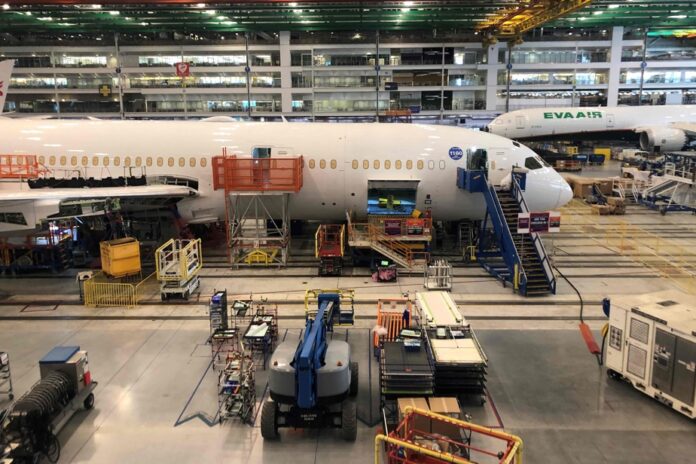(North Charleston) On the assembly line of its 787 Dreamliners, Boeing is working to speed up production rates and respond to airlines’ renewed appetite for long-haul flights after a period weighed down by repeated delivery interruptions for cause. manufacturing defects.
At the start of the first production line in a hangar in North Charleston, South Carolina on the east coast of the United States, the wings, cockpit, cabin and tail of the aircraft are still detached.
It will take about a month for the components to be hooked up and the interior fitted, with the aircraft comprising 2.3 million parts in total. The final touches are made on the parking lot.
Boeing has already managed to increase the production rate from less than two 787 per month at the end of 2021 to four, and hopes to increase to five by the end of the year.
On the second line, three aircraft installed in the opposite direction are inspected. Already completed but not yet delivered, they had to return to the shed after the discovery since the summer of 2020 of several production defects to be scrutinized and, if necessary, adjusted.
Boeing still has several dozen planes to review but plans to do so entirely from its factory in Everett, in the northwestern United States, by the end of the year. The second line in Charleston can then be dedicated to assembly, bringing production to ten 787s per month by 2025-2026.
The group would then approach the rate of 14 aircraft per month before the pandemic, when assembly was spread over two sites, in North Charleston and Everett. Boeing made the decision in late 2020 to consolidate production of all versions of the 787 on the East Coast.
The manufacturer is not worried about possible cancellations of orders by customers annoyed by the delays.
“Our problem right now is mostly delivering these planes to customers. They want them and they want them fast,” said Lane Ballard, 787 program manager, during a press visit Tuesday and Wednesday to Boeing sites in South Carolina in preparation for the Paris Air Show. June 19-25.
After the rebound last year of its flagship aircraft, the medium-haul 737 MAX, which allowed Boeing to deliver its best performance in terms of deliveries since 2018, the manufacturer is banking on the 787 to return to better financial health. after four consecutive years in the red.
The drop in air traffic on long flights during the pandemic had plunged the wide-body aircraft market, already ailing before the pandemic. But orders have picked up in recent months.
Boeing, with the 787 and 777, has historically dominated this higher-margin segment, with Airbus rivaling its A350s and A330s.
After the shutdown of the very jumbo 747, the shortness of the 777 in the passenger version and the delay in the certification of the 777X, which will only occur in 2025, i.e. five years behind schedule, Boeing is counting on the 787.
The manufacturer had made a bet when the program was launched in 2004 by choosing composite materials based on carbon fibers for the fuselage and the wings instead of metal alloys. The aircraft is lighter and therefore consumes less fuel.
The rear of the aircraft is also produced at the North Charleston site, in an adjacent hangar, while the rest of the large parts are brought in from Italy, Japan and Kansas, in one of four Boeing Dreamlifters, 747 specially modified for the transport of bulky goods.
The 787, which entered service in 2011, has racked up more than 250 orders in the past six months.
“It’s virtually guaranteed that by the end of the year, the 787 will be the most popular passenger jumbo jet in history,” said Darren Hulst, Boeing’s commercial aircraft marketing manager, with orders exceeding Boeing 777 and Airbus A330.





